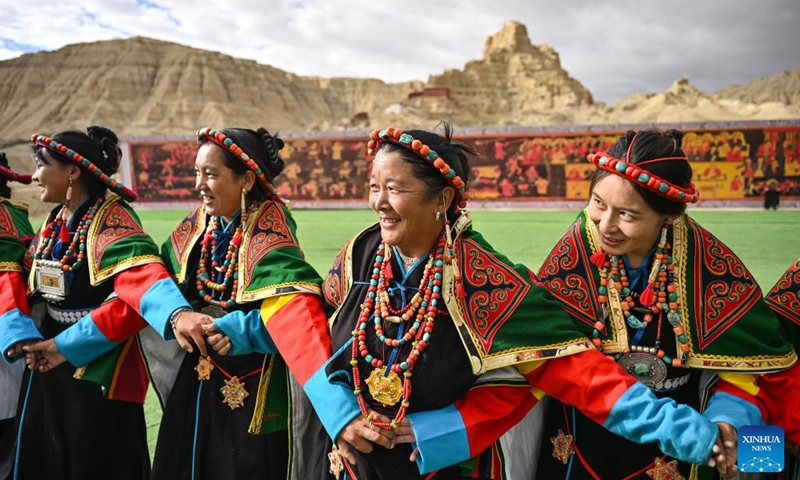
Local residents perform Xuan Dance near the ruins of the Guge Kingdom in Zanda County of Ngari Prefecture, southwest China's Xizang Autonomous Region, Sept. 11, 2024. The dance is a Tibetan cultural heritage from the ancient Guge Kingdom that mixes speech, singing and dancing. It was inscribed into the national intangible cultural heritage list in 2008. (Photo: Xinhua)
"The work of aiding Xinjiang and Xizang serves as a crucial means to enhance interactions, exchanges and integration among various Chinese ethnic groups, thereby reinforcing the development of a community with a shared future and building a shared spiritual home for the Chinese nation," Pan Yue, director of China's National Ethnic Affairs Commission, remarked at a conference on the current progress achieved in supporting the development of the Xinjiang and Xizang autonomous regions on Thursday.
Pan also stressed the critical role of cultural works, noting that local authorities should enhance the charm of the fine traditional culture of the two regions through diverse cultural products and methods, and concentrate on telling stories regarding the Chinese national community.
At the conference held in Beijing, deputies of local ethnic affairs commissions of different places around China such as Northwest China's Xinjiang Uygur Autonomous Region, Southwest China's Xizang Autonomous Region, South China's Guangdong Province and Central China's Hubei Province addressed the endeavors and achievements of ethnic affairs in the two regions under the support of the whole country.
Thanks to abundant cultural resources from other places and joint efforts, more than 1,000 cultural projects and almost 900 exhibitions on specific subjects have been launched in Xinjiang, providing millions of local residents with plenty of quality cultural products, according to the local ethnic affairs commissions.
Behind the data is a wealth of diverse and compelling stories that foster cultural and artistic exchanges among various ethnic groups.
During the folk-art season themed "Play the tambourine and sing a song" that kicked off in August, 53 teams of more than 1,700 folk artists from different regions and ethnic groups gathered in Xinjiang and presented a string of parade performances. Professional opera troupes also brightened the event by virtue of an artistic feast involving some classic operas such as the Kunqu Opera The Peony Pavilion.
Other activities, including exhibitions regarding cultural creative products and fairs teeming with booths featuring diverse intangible cultural heritages, have also been carried out.
Supportive cultural projects have also been launched in Xizang. A branch of the Guangzhou Library was opened to the public in September 2023 in Bomi county through collaboration between the Guangzhou Library and the county library.
A selection of 10,000 books from Guangzhou served as the basic collection for the branch library, which is the first one built by the Guangzhou Library outside of Guangdong Province. The library provides free book lending service to the public and is open for at least 63 hours a week, according to the Guangzhou Daily.
An exhibition of imperial court ceremonies and life during the Qing Dynasty (1644-1911) has been presented by the Palace Museum in Beijing for Xinjiang residents since November 2021. It prominently showcases over 120 exquisite gold and jade artifacts from the collection of the Palace Museum used by the Qing Dynasty imperial family.
These items include various types of artifacts such as ceremonial vessels, ritual implements, decorative items, and daily necessity items. These cultural relics bear witness to the process of integration and development among various ethnic groups in the country, and fully demonstrate the close connections throughout the history of the Chinese nation, including the diverse ethnic groups in Xinjiang, as well as China's shared culture and intertwined roots, the Guangming Daily reported.
To promote bright film works and talented filmmakers in Xinjiang and Xizang, the Beijing International Film Festival has made films about the stories of these two areas one of its important sections.
"Compared to economic support such as infrastructure construction and investment, cultural support can make an impact similar to how the spring wind turns clouds into rain, nourishing the spiritual life of local residents in Xinjiang and Xizang," Xiong Kunxin, a professor at Minzu University of China in Beijing, told the Global Times on Thursday.
Xiong noted that besides enhancing exchanges among various ethnic groups, the cultural aid projects such as world heritage applications can also better conserve ethnic groups' unique culture and boost people's confidence in their ethnic heritage.
To address challenges in other sectors that affect residents of Xinjiang and Xizang, several aid projects have been launched, including training preschool teachers and enhancing medical techniques, all of which have significantly improved the quality of life for local residents.




